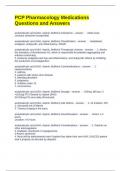PCP Pharmacology Medications
Questions and Answers
acetylsalicylic acid (ASA, Aspirin, Bufferin) Indications: - answer Adult acute
coronary syndrome (suspected)
acetylsalicylic acid (ASA, Aspirin, Bufferin) Classification: - answer antiplatelet,
analgesic, antipyretic, anti inflammatory, NSAID
acetylsalicylic acid (ASA, Aspirin, Bufferin) Therapeutic Actions: - answer 1. blocks
the formation of thromboxane A2, which is responsible for platelets aggregating and
arteries constricting
2. produces analgesia and has anti-inflammatory, and antipyretic effects by inhibiting
the production of prostaglandins
acetylsalicylic acid (ASA, Aspirin, Bufferin) Contraindications: - answer 1.
Hypersensitivity
2. asthma
3. patients with active ulcer disease
4. bleeding disorders
5. pregnancy
6. children under 15
7. unconscious
acetylsalicylic acid (ASA, Aspirin, Bufferin) Dosage: - answer 160mg, (81mg x 2
=162mg) PO Chewed no repeat (AHS)
50-325mg PO once daily (Provincial)
acetylsalicylic acid (ASA, Aspirin, Bufferin) side effects: - answer 1. GI irritation, N/V
2. Increased risk of bleeds
3. Tinnitus (ringing in the ears)
acetylsalicylic acid (ASA, Aspirin, Bufferin) Onset/Duration: - answer Onset: 1-2
hours
Duration: 4-5 hours
acetylsalicylic acid (ASA, Aspirin, Bufferin) Considerations: - answer 1. Patients on
other anticoagulants
2. Diabetics monitored or hypoglycemia
3.Reye's syndrome
4. Must still be administered even if patient has taken their own ASA, UNLESS patient
took it properly as directed by dispatch
, Dextrose in water (D10W, D25W, D50W) Indications: - answer Head injury,
hypoglycemia, stroke
Dextrose in water (D10W, D25W, D50W) classification: - answer Caloric agent
Dextrose in water (D10W, D25W, D50W) therapeutic actions: - answer 1. increases
blood sugar levels to normal cases in hypoglycemia
2. hyper-tonic solutions producing a transient movement of water from interstitial spaces
into the venous system (osmotic diuretic)
Dextrose in water (D10W, D25W, D50W) indication: - answer 1. severe,
symptomatic hypoglycemia from any cause
2. head injury with symptomatic hypoglycemia
3. stroke with symptomatic hypoglycemia
Dextrose in water (D10W, D25W, D50W) Contraindications: - answer 1. allergy to
corn products
2. hypersensitivity
3. intracranial hemorrhage (half the dose)
4. hyperglycemia
Dextrose in water (D10W, D25W, D50W) Dosage: - answer 25g SIVP/IO q 5 min
prn, titrate to BGL greater than o equal to 4.0mmol/L or patient improvement to a max of
50g
Dextrose in water (D10W, D25W, D50W) Onset/Duration: - answer Onset: less than
1 minute
Duration: varies
Dextrose in water (D10W, D25W, D50W) Considerations: - answer 1. tissue necrosis
(give half the dose and check IV patency)
2. utilize a large bore catheter in a large vein
3. DW50 has a short duration of action, therefore follow with a complex carbohydrate
4. Wernicke's Encephalopathy (lack of thiamine)
5. Korsakoff's syndrome (severe deficiency of thiamine)
6. monitor vitals, LOC, BGL
7. Increased risk of intracellular acidosis and neuronal death
Dextrose in water (D10W, D25W, D50W) Side effects: - answer pulmonary edema,
phlebitis, tissue necrosis, rebound hyperglycemia
Epinephrine (adrenaline) classification: - answer sympathomimetic
Epinephrine (adrenaline) Actions: - answer Alpha 1 agonist: peripheral
vasoconstriction improving coronary and cerebral perfusion




